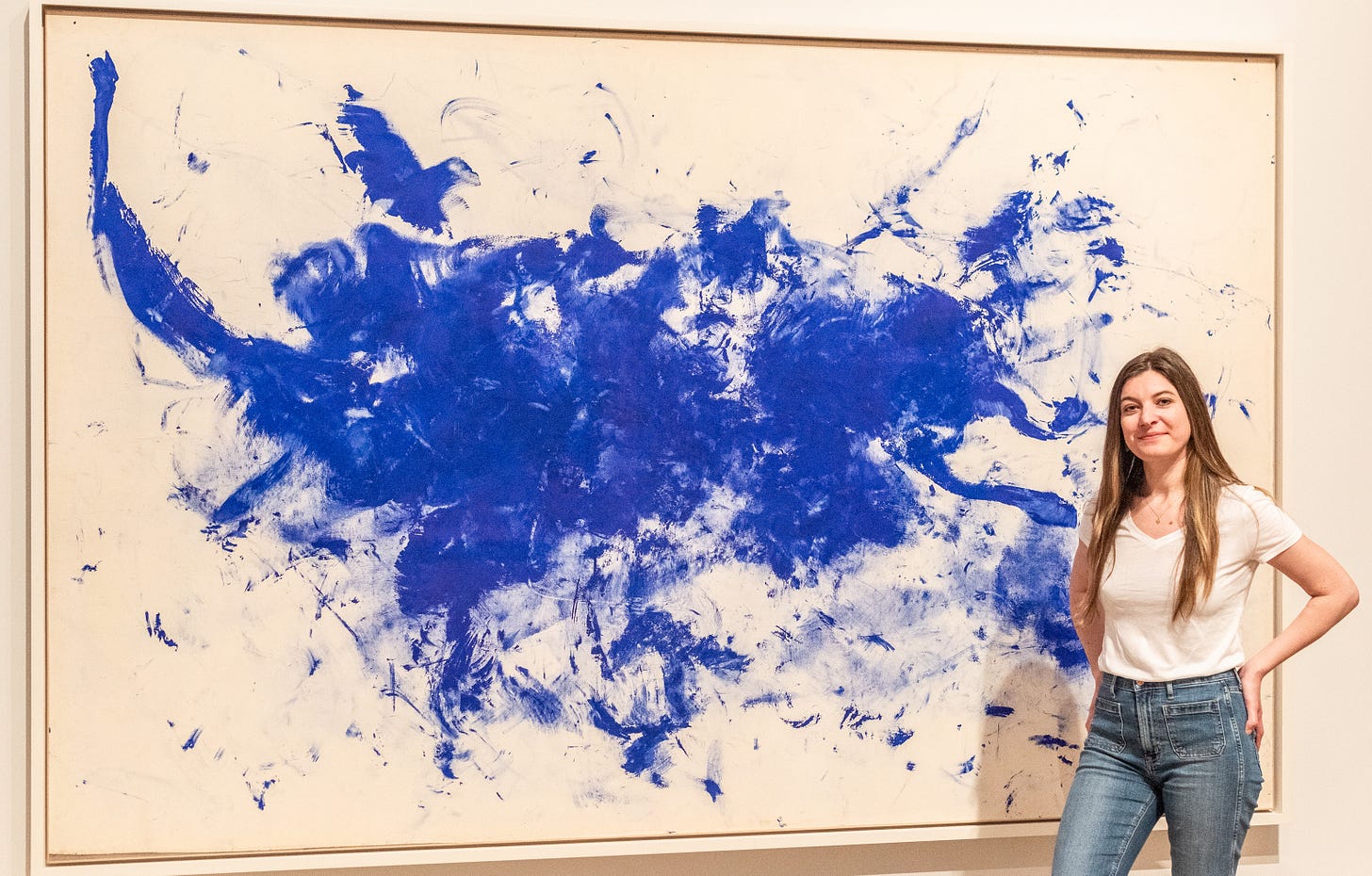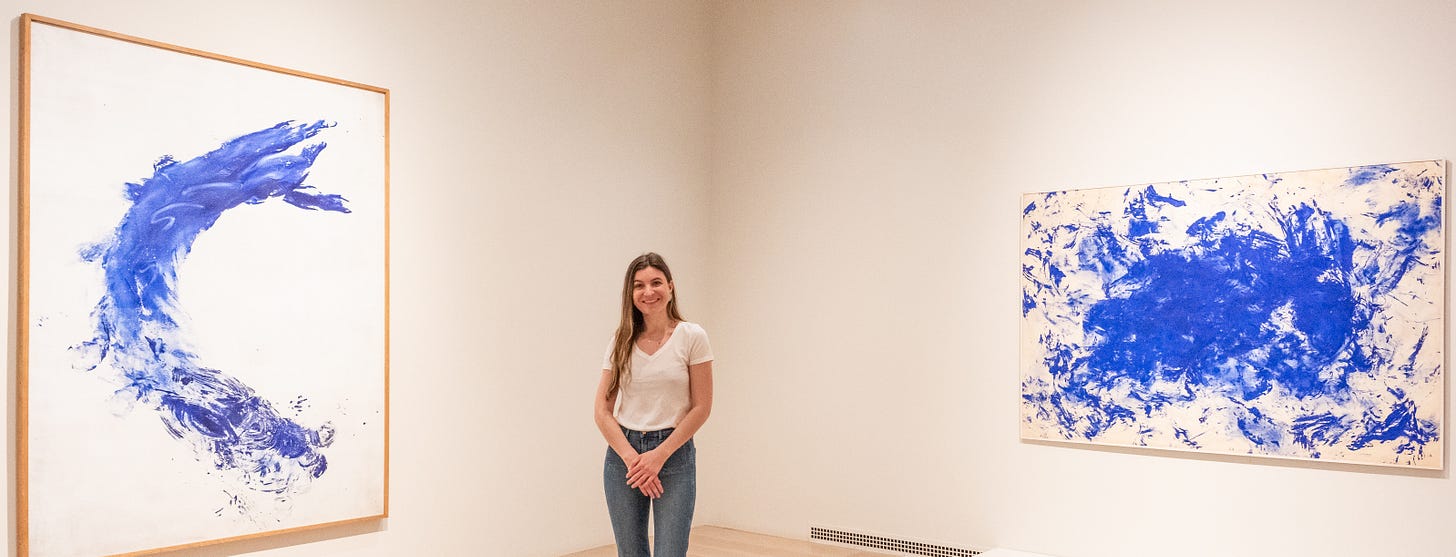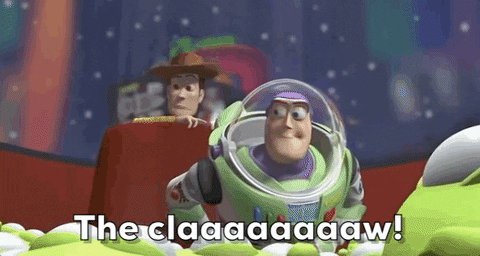Art Snobs & Yves Klein
I still don't get it...

I first became conscious of Yves Klein during an art history class about Picasso. I had signed up for a heady, weird seminar about Picasso’s intellectual aspirations as a painter, and I soon learned that I was the only registrant.
“You’re insane,” my friend told me. It turned out that registrations were so low because the class’s instructor had found himself on the losing end of some sort of confusing, internecine art-history squabble. Many people had sided with the opposing intellectual camp, and I had unwittingly stepped into the drama.
At that point, I was only tangentially involved in art history. I was taking classes in a mix of disciplines, I was about to finish graduate school, and I had realized that the art world probably wouldn’t be in my future, at least full-time. I had stared at enough paintings with people who cared significantly more than I did to make that realization.
I like art history when it has something provocative–preferably borderline-crazy–to say and I felt that this seminar could deliver that, so I showed up alone to the first class. To the professor’s credit, he showed up, too. He told me that he was happy to teach the course even to one person, because the subject material mattered. I respected him for that. So we spent the semester together staring at slide after slide of Picasso’s paintings.
I still couldn’t tell you what I learned. I was repeatedly assured by the professor that Picasso was “basically a rocket scientist.” The professor’s arguments often went over my head but my intuition told me that there really was an intellectual “there” there, so I continued trying to understand. The professor kept saying something about Picasso drawing with his hand instead of his eye–I don’t know.
I often felt so lost that I might as well have been in an actual rocket-science class. Our cold interpersonal relationship reflected this reality. We were like two ships passing across the picture plane. I genuinely don’t think he even knew my name. Let’s just say that I was definitely the Pinky to his Brain.
We had quite a few Pinky-and-the-Brain moments together, but our Yves Klein experience was a standout. Yves Klein (1928-1962), whose brief but influential life and career coincided with the final decades of Picasso’s life, had appeared in my reading for the class. You’ve probably seen Yves Klein’s iconic paintings of blue painted silhouettes on huge white canvases. I casually mentioned Yves Klein to him, and this was good because it’s how I learned that Klein’s name is emphatically not pronounced like the “ves” in “vest” and “Klein” like “Anne Klein.” Rather it is pronounced “Eve Claw” with a very heavy, fake French accent, regardless of your nationality.
My Eve Claw pronunciation lesson is now a fond memory. So when I saw billowy blueish signs for the exhibition “Yves Klein and the Tangible World” at the Lévy Gorvy Dayan gallery last month, I felt as if I had spotted a celebrity. I literally exclaimed in public to myself, “Wow, Eve Claw!”
The stately, airy two-floor exhibition mainly consisted of Yves Klein’s famous blue Anthropométries (1960–62) and the less well-known but similar Peintures de feu, or Fire Paintings (1961–62). All of these paintings portray real female forms. Female models would literally cover themselves in a bright ultramarine paint that Klein developed and officially named International Klein Blue (IKB), and these models would press their bodies in various ways, sometimes in public for onlookers in tuxedos and formal gowns, onto canvases. For his equally absorbing Fire Paintings, Klein literally used a flamethrower and had a friend don firefighting equipment for these orangish-brown artworks.
I saw the exhibition twice and the paintings took my breath away. My only regret was that I forgot to wear my t-shirt with lobsters on it–a gift from my uncle–that says “Simply Clawsome.”
Eve Claw is a complicated figure and his work sits at the interstices of a diverse, thorny set of sensitivities. There’s the obvious issue of the naked models. Projected onto the walls of Lévy Gorvy Dayan, visitors could view old, grainy black-and-white footage of these women, undulating on the floor and lacquered in IKB paint, while Klein directed them and the audience watched.

Then there are the divergent opinions about the artistic value of Klein’s oeuvre. Eve Claw was basically asking people to accuse him of being a charlatan. One scholarly source states simply: “From the start, Yves Klein touches on the theme of the fraudulent.” International Klein Blue (IKB) is actually just a very bright blue with a resin component that helps it maintain its ultra-vibrant color. Klein also created and disseminated artificial “exhibition catalogues” featuring colored swatches portrayed as original artworks in pitch-perfect, imitative leaflets. He famously had himself photographed “flying” (he edited out the mattress catching his body). Obsessed with the idea of “immateriality,” he sold people thin air in exchange for gold bars. He exhibited nothing in a show called “The Void.” And so on.
He was also accused of dilettantism–Klein was a judo master among other things before alighting upon his short art career. Having died of a heart attack at age 34, Klein could not give us a full sense of his artistic trajectory.
Yet Klein’s aesthetic sense is amazing. As one critic rightfully points out, those “fake” exhibition pamphlets really are stunningly beautiful. And that’s to say nothing of the paintings at Lévy Gorvy Dayan.
If I had to put a stake in the ground, I’d say that Eve Claw had a wonderful and forward-thinking eye, he really wanted to make his mark on the world, and he was an extreme person all-around. He was fanatically serious about both his work and his spiritual life.
A moving interview with Klein’s widow, French artist Rotraut Klein-Moquay (née Uecker), best helped me understand Eve Claw. The film portrays Rotraut (I’ll use her first name for simplicity) as sad, contemplative, and admiring about the loving partner she met at 19 years old. Rotraut is still his greatest advocate and defender. When her interviewer pushes her about Klein’s crazy stunts like the jumping photo, she says simply: “He had to do it.” As for the lesson in this work? “Try to elevate yourself. Try to grow.”
Rotraut, we learn, was one of Klein’s models. Combating the narrative that these women were passive victims of Klein’s misogyny, Rotraut describes the process as a truly spiritual experience during which her body and soul came together as one. Rotraut tells us that the models loved working with Klein because he let them be active participants in his artmaking process. Sure enough, when I re-watched footage, I suddenly noticed the models’ panache, their swagger.
Rotraut also regarded Klein’s drastic nature compassionately. She learned from Klein, she says, not to be “too extreme into spirituality” and that “you never should forget the flesh.” Bottom line? “Everything in balance.”
My friend Aneesha happened to be in New York City during the Yves Klein exhibition. Downtown at a library-turned-bar, I told her my Eve Claw story and she threw her head back in laughter. Aneesha loves Yves Klein–she even painted her ceiling in International Klein Blue (IKB)! She is a person with a serious and abiding interest in home design. Yet Aneesha is also a generous appreciator of the ridiculous. She has a knack for being in environments but not of them–what a worthy way to wander through the art world.
So how did that Picasso class turn out? When my art history friends asked how it was going, I would mutter, “Well, you know, he drew with his hand instead of his eye.” In class I tried my best to meaningfully engage with the Brain and I wrote some middling, muddled final paper that sounded like a drug trip. I signed it Pinky.
What most bothered me were my inter-departmental conversations about Yves Klein, Picasso, and their ilk. It is intellectually stylish in some spaces to cynically flatten very complicated issues as if they are simpler than they actually are, and then to marvel with false amazement that everyone else could be so blind to this “simplicity.” It was frustrating to wish art historians would explain these topics to me as if I were in kindergarten, then to be around the type of people who would say that their kindergartener could have made this or that painting!
I see now that it is okay to detach from art snobbery—in whatever form—and simply appreciate an artwork’s sheer visual beauty. Rotraut said that Yves Klein’s paintings are timeless, and I completely agree. Yves Klein had style, and the exhibition at Lévy Gorvy Dayan really was, well, simply clawsome.
I would tell you to go see the exhibition, but it closed on May 25. That’s right—you missed it, you peasants!
